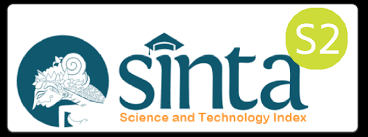What Can We Learn from the ELPSA, SA, and PSA Frameworks? The Experience of SEAQiM
Abstract
One of education problems in Indonesia according to Dr. Anies Baswedan, the former Minister of Education and Culture of the Republic of Indonesia, was: “How to help Indonesian students to be independent learners and have good characters?” This question then raises an issue: “What kinds of knowledge, skills, and attitudes are needed by our students to survive in the 21st Century and beyond?” Earlier the author stated (Shadiq, 2016a) that to change and improve the quality of the teaching and learning process from a ‘typical’ or ‘traditional’ mathematics classroom to a more innovative one was not easy. A
further issue was: “How to change real teaching practice?” Mathematics teachers need to experience ways that they will be expected to implement in their teaching. Isoda (2011) proposed a Problem Solving Approach (PSA) which consists of four steps: (1) problem posing, (2) independent solving, (3) comparison and discussion, and (4) summary and integration. In Indonesia, we can learn from Scientific Approach (SA) which covers five steps: (1) observing, (2) questioning, (3) collecting data or experimenting, (4) reasoning, and (5) communicating. In addition, Lowrie and Patahuddin (2015) proposed Experiences, Language, Pictures, Symbols, Application (ELPSA) as a lesson design framework for mathematics teaching and learning process. A problem is examined based on these three frameworks where at least 11 alternatives can be identified to solve it. The paper ends with some recommendations on how to improve Indonesian mathematics teaching.
Keywords
Full Text:
PDFReferences
Askew, M. (2013). Launching futures: You can’t drive by looking in the rearview mirror. In S. Herbert, J. Tillyer, & T. Spencer (Eds.), Proceedings of the 24th Biennial Conference of the Australian Association of Mathematics Teachers (pp. 4-13).Adelaide: The Australian Association of Mathematics Teachers (AAMT) Inc.
De Lange, J. (2004). Mathematical literacy for living from OECD-PISA perspective. Paris:OECD-PISA.
Darling-Hammond, L. (2000). Teacher quality and student achievement. Education Policy Analysis Archives, 14(1), 162-183.
Fitzgerald, M., & James, I. (2007). The mind of the mathematician. Baltimore: The Johns Hopkins University Press.
Goos, M., Stillman, G., & Vale, C. (2007). Teaching secondary school mathematics:Research and practice for the 21st century. NSW: Allen & Unwin.
Isoda, M., & Katagiri, S. (2012). Mathematical thinking. Singapore: World Scientific.
Kemendikbud (2014). Gawat darurat pendidikan di Indonesia. Power Point presented by the Minister of Education and Culture of the Republic of Indonesia in front of the Head of Education and Culture Districts Offices. Jakarta: Kemendikbud.
Lowrie, T., & Patahuddin, S. M. (2015). ELPSA – Kerangka Kerja untuk Merancang Pembelajaran Matematika. Jurnal Didaktik Matematika, 2(1), 94-108.
MoEC (2014). Implementasi kurikulum 2013. Jakarta: Kemdikbud.
National Council for Teachers of Mathematics (NCTM) (2000). Principles and standards for school mathematics. Reston VA: author
National Research Council (NRC) (1989). Everybody counts. A Report to the nation on the future of mathematics education. Washington DC: National Academy Press.
SEAMEO RECSAM (2016). Working paper for SEA-BES: Common core regional learning standards in science and mathematics. Penang: SEAMEO RECSAM.
SEAMEO RECSAM (2015). SEA-BES: Common core regional learning standards in mathematics framework for the 21st century. Retrieved from
https://fadjarp3g.wordpress.com /2016/07/27/standards-for-mathematics-and-scienceteacher-and-standards-on-basic-education-for-mathematics-and-science/
Shadiq, F. (2010). Identifikasi kesulitan guru matematika SMK pada pembelajaran matematika yang mengacu pada permendiknas No. 22 Tahun 2006. Edumat: Jurnal Edukasi Matematika, 1(1), 49-60.
Shadiq, F. (2015). How can SEAMEO QITEP in Mathematics helps Indonesian mathematics teachers to help their students to be independent learners in the case of disaster risk reduction (DRR)? Paper presented on Conference on Science and Mathematics Education (CoSMEd), SEAMEO RECSAM, Penang, Malaysia, 16-19 November,
Yogyakarta: SEAMEO QITEP in Mathematics.
Shadiq, F. (2016a). The opportunities and challenges on the teaching and learning of mathematics: Experience of SEAMEO QITEP in Mathematics. Power Point Presented on the Workshop on Promoting Mathematics Engagement and Learning Opportunities for Disadvantaged Communities in West Nusa Tenggara in Australian Embassy, Jakarta, 12 May, 2016. Yogyakarta: SEAMEO QITEP in Mathematics.
Shadiq, F. (2016b). The Japanese problem solving approach (PSA). Power Point Presented on Course on Joyful Learning for Primary School Teachers. SEAMEO QITEP in Mathematics, Yogyakarta, 24 August-6 September 2016. Yogyakarta: SEAMEO QITEP in Mathematics.
White, A. L. (2014). Recipes for success: Essential ingredients for good mathematics teachers and teaching. In A. L. White, S. Tahir, & U. H. Cheah, (Eds.), Empowering future generations through mathematics education (pp. 142-160). Penang Malaysia:SEAMEO RECSAM.
DOI: https://doi.org/10.46517/seamej.v7i1.46
Refbacks
- There are currently no refbacks.
Indexed by:
Southeast Asian Mathematics Education Journal
SEAMEO Regional Centre for QITEP in Mathematics
Jl. Kaliurang Km 6, Sambisari, Condongcatur, Depok, Sleman
Yogyakarta, Indonesia
Telp. +62 274 889955
Email: seamej@qitepinmath.org
p-ISSN: 2089-4716 | e-ISSN: 2721-8546
Southeast Asian Mathematics Education Journal is licensed under a Creative Commons Attribution 4.0 International License
View My Stats
Supported by:



